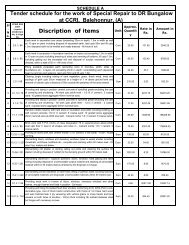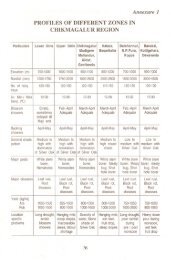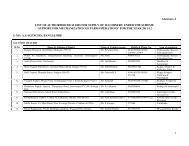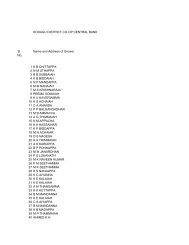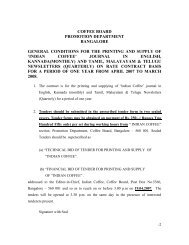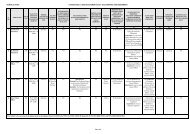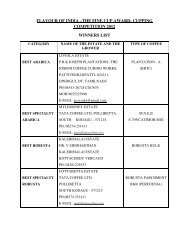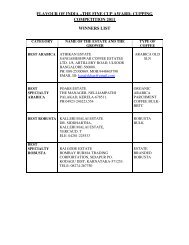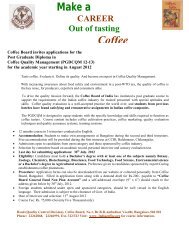COFFEE CULTIVATION GUIDE - Coffee Board of India
COFFEE CULTIVATION GUIDE - Coffee Board of India
COFFEE CULTIVATION GUIDE - Coffee Board of India
Create successful ePaper yourself
Turn your PDF publications into a flip-book with our unique Google optimized e-Paper software.
cherry produces rattling sound when shaken and a sample forlit records the same<br />
weight on two consecutive days. At the end <strong>of</strong> the harvest, the remaining fruits on the<br />
plants should be completely stripped and fallen fruits should be gleaned cleanly. If<br />
this method <strong>of</strong> complete stripping and gleaning is not followed, there is a danger <strong>of</strong><br />
<strong>C<strong>of</strong>fee</strong> Berry borer infestation during the coming years. Stripped and gleaned c<strong>of</strong>fee<br />
should be dried separately and should not be mixed with other c<strong>of</strong>fee.<br />
5. Seed <strong>C<strong>of</strong>fee</strong> Preparation<br />
Select the vigorous, highly productive, pest and disease free c<strong>of</strong>fee plants for<br />
collecting the seed c<strong>of</strong>fee. While selecting the plants, only such plants which have<br />
not suffered from any diseases for a long time in the field should be selected. After<br />
selection <strong>of</strong> the plants, blossom should be forced on these plants by irrigation well<br />
before the general blossom shower. This will avoid any cross pollination from the<br />
undesired plants. From these plants select and harvest healthy ripen fruits. After the<br />
harvest, segregate floats and half ripe fruits and hand pulp the well matured fruits. The<br />
pulped beans are then mixed with sieved wood ash and dried slowly under shade in 5<br />
cm thickness. Seed c<strong>of</strong>fee should not be prepared from Berry Borer affected areas.<br />
Before sowing, the seeds should be treated with Bavistin (Mix thoroughly 1 gm<br />
Bavistin 50 WP with one kg <strong>of</strong> seeds) to avoid any fungal attack.<br />
6. White Stem Borer Control<br />
Adopt all the control measures to manage the c<strong>of</strong>fee White Stem borer as<br />
explained in earlier pages.<br />
7. Soil Testing and Liming<br />
34<br />
In order to grow healthy c<strong>of</strong>fee plants and to realize better crop, it is very<br />
important to protect primarily the soil health. The various plant nutrients in the soil<br />
need to be maintained in balance so that the soils remain productive for a long time.<br />
The acidity (pH) determines the productivity <strong>of</strong> the soil and nutrient<br />
assimilation/mineralization in the soil. In order to have better fertilize use efficiency<br />
<strong>of</strong> the applied fertilizers, the soil pH should be maintained at around 6.1 in c<strong>of</strong>fee<br />
soils. Due to the continuous application <strong>of</strong> acid causing fertilizers like ammonium<br />
sulphate, ammonium chloride and DAP and due to the leaching <strong>of</strong> calcium and<br />
magnesium elements in the soil, the soils tend to become acidic. Therefore, to monitor<br />
the soil pH, soils have to be tested compulsorily once in 2-3 years. When the soil pH<br />
goes above 6.2 or comes below 6.1, the soil pH needs to be corrected because the<br />
availability <strong>of</strong> essential plant nutrients depends on the soil pH. Strongly acidic soils<br />
(pH below 4.5) are relatively poor in productivity because <strong>of</strong> essential plant nutrient<br />
deficiencies or toxicities <strong>of</strong> essential or non essential elements. Highly acidic soils are<br />
harmful for the useful soil micro-organism and in such soils c<strong>of</strong>fee plant growth is<br />
always tend to be stunted in nature. If the soils are alkaline (above pH 7.0), most <strong>of</strong><br />
the essential plant nutrients are not available to the plants.<br />
Whenever, the c<strong>of</strong>fee soil pH falls below 6.1, the soil pH should be corrected by<br />
the application <strong>of</strong> alkali forming soil amendments like agricultural lime(Calcium<br />
Carbonate), dolomite ( Calcium and Magnesium Carbonates). Liming <strong>of</strong> the c<strong>of</strong>fee<br />
soils can be done anytime <strong>of</strong> the year except during monsoon period. However,<br />
keeping in mind the c<strong>of</strong>fee zones, it is known that November to February months are<br />
the ideal period for lime application. One should take care that adequate moisture is<br />
present in the soil for the best use <strong>of</strong> applied lime. Liming materials has to be<br />
34



